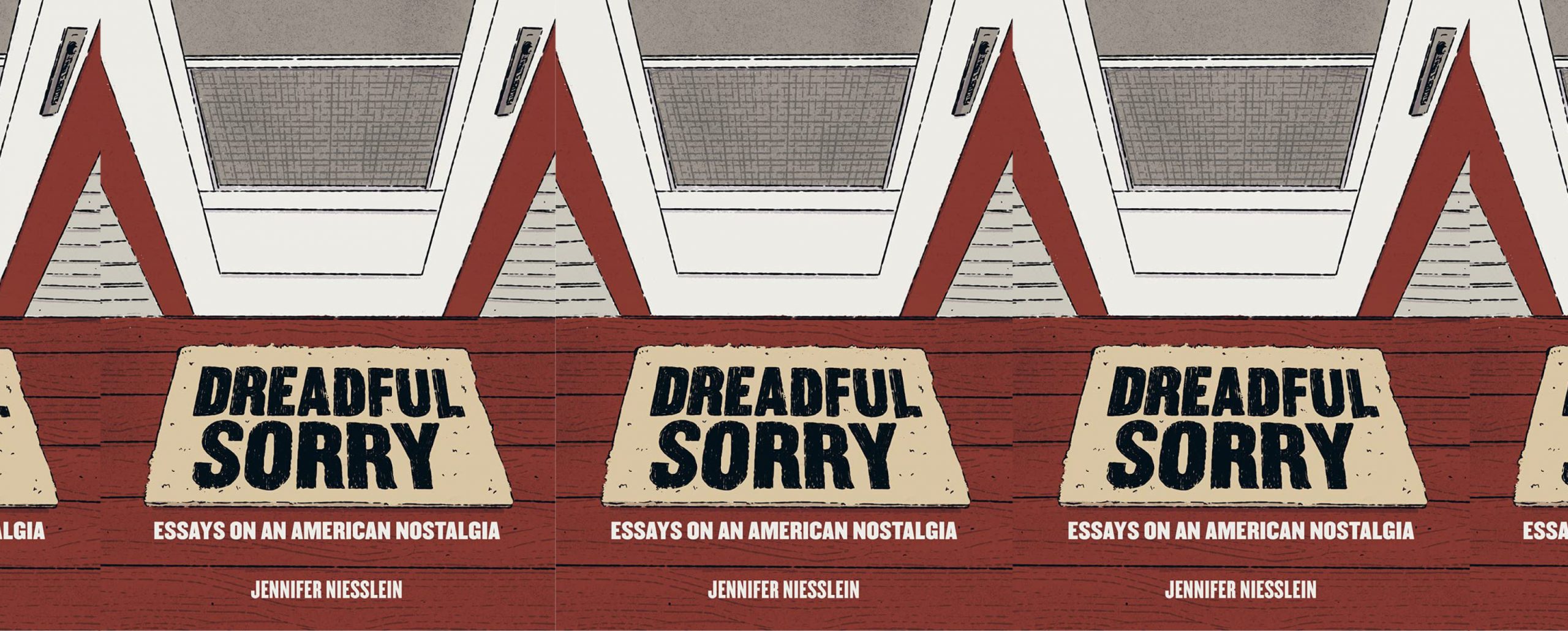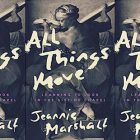Dreadful Sorry’s Exploration of American Nostalgia

In her introduction to Dreadful Sorry: Essays on an American Nostalgia, Jennifer Niesslein investigates the meaning of nostalgia, beginning with its origins in 1688 as a medical diagnosis defined by a Swiss doctor, Johannes Hofer, based on his observations of displaced and homesick students, workers, and soldiers in Europe. In the years since, Niesslein explains, nostalgia has been seen as both an illness and a character defect. It has been cultivated by some, such as the Romantics, and scorned by others, who see it as unsophisticated. For some time, it was believed that Americans did not suffer from nostalgia—the country was too new; its citizens were looking ahead to the future. And then came the Civil War—a military doctor diagnosed nostalgia among Union soldiers (it appears to be an early recognition of what we now call post-traumatic stress disorder). Afterward, dangerous varieties of nostalgia for the antebellum years took hold through the myth of the Lost Cause.
Niesslein calls herself “an American nostalgic.” Her nostalgia is American not only because the people and places she longs for are American, but because her “background of displacement, albeit less traumatic than writers who’ve been, for ethnic and political reasons, forced from their homelands,” is American. So is the fact that the “idyllic childhood” that she looks back at “in a golden light” was made so because, despite the deprivations suffered by her own ancestors, she was mostly sheltered from the complexities, unfairness, and brutality of the world. This shelter was available to her because, though she was neither wealthy nor privileged, she was white. She examines this fact throughout her collection.
Examining her whiteness is one aspect of Niesslein’s process of examining the problems with nostalgia, including its distortions of the past and regressive tendencies. She writes, “I live in Charlottesville, Virginia, and I’ve seen firsthand what happens when white men romanticize the past, whether it’s the Confederacy, the Nazi regime, or some fuzzy idea that the natural order is white men first. In times of backlash against progress, both the regressive powerful and the regressive fringe look to the past. For most of us, the very worst of it.” But the paradox is that Niesslein’s nostalgia is what drives her to examine and deconstruct her nostalgia. She writes, “Nostalgia appeals to me because it can link us to the past—a kind of gateway to understanding our history.” By drawing her attention to the past, nostalgia compels her to look more closely, allowing her to see what she might have missed before.
In the first essay in the collection, seeing what she might have missed transforms Niesslein’s nostalgic view of the past into what she calls “plain old history”—a story based on evidence, without the “glossing over of the details” or imaginative embellishments that nostalgia permits. This essay begins with the murder of her grandmother’s grandmother, Annie Fisher: “Growing up, I only knew three things about her: The legend was that her husband, a coal-miner like so many Polish immigrants, was in ‘frail health,’ and as a result, she took up bootlegging—and was successful enough at it to own three houses. Her fourth child, her youngest, was rumored to be of mixed race. And she was murdered.” Because she knew so little, and because the little she knew was so charged with drama, Niesslein mythologized her great-great grandmother. She writes, “On these barest of bones, I pressed on flesh that reflected the fantasy of who I’d be if my back were to the wall. A badass! A proto-feminist! An outlaw! A woman who landed on her feet when times got tough! Myths, of course, always represent the imagination of the mythmaker.” What Niesslein, the mythmaker, wanted from the story of her great-great grandmother was some reassurance that she, like her ancestor, had the strength to survive even with some bravado on the margins. Annie herself—like Niesslein’s great grandmother and grandmother—wanted something else. She wanted to find a place securely within the margins, as a “respectable” white.
Both mythmaking and making a bid for respectability demand a kind of obfuscation. Crediting Traci D. O’Neal’s 2018 book The Exceptional Negro: Racism, White Privilege, and the Lie of Respectability Politics with the insight, Niesslein explains that to become respectable is to assimilate, adopting the dress, mannerisms, biases, and speech of the mainstream, respected class—meaning, in other words, that it is to disavow one’s own ways and people, such as the people in Niesslein’s family whom her grandmother warns “you don’t want to talk to.” The mythmaker, on the other hand, tends to romanticize what others might disavow. Looking through the documentary and physical evidence, however, Niesslein finds a story that is far less romantic than the myth she had made about her great-great grandmother. Reading a newspaper report from the time and examining Annie’s death certificate, for example, Niesslein learns that after her great-great grandmother’s body was found on the roadside near a creek, her death did not matter enough to the authorities to warrant a proper investigation. And going back with her grandmother to see her grandmother’s childhood hometown, she sees both the home that her grandmother lost after Annie’s death and the barely adequate company housing where her grandmother lived after the loss. “I have no poker face, and I think my expression showed the gulf between my life and hers,” writes Niesslein. “The reality—the poverty—of it hadn’t hit me until then.”
In other essays, Niesslein examines people and places she herself knew or knows. In “Respect,” for example, she compares her ancestors’ desire for respectability with her mother’s desire for respect and finds a version of second-wave feminism that accommodates her family’s working-class roots, which she characterizes as the nostalgic view of the movement overlooks. In “Little Women,” she reflects on the significance of Louisa May Alcott’s story to her as the member of a family of four sisters with a strong and much-admired matriarch, and realizes one benefit of “personal nostalgia”: one of the siblings will ultimately be the first to die, and so, she writes, “Sometimes there’s a good reason to avoid looking to the future…Nostalgia knows that the future holds loss.” In another pair of essays, she revisits her childhood homes, first the small town in western Pennsylvania where she lived from when she was five until she was eleven, and then the Washington, D.C. exurb where her family moved after the steel industry “tanked” and her father lost his job.
To Niesslein, New Galilee, PA, was idyllic. Even on a visit in 2017, looking at the town with adult eyes, she finds that a memory “clings to me: I’m on my bike, sailing around New Galilee. I sail through the entire town. The wind tangles my hair into reddish, brown-gold knots. I stand up on my pedals and glide down Washington Street until I need to pump again. For once, my sisters aren’t on the banana seat with me or perched on the handlebars. I’m free, I’m free, I’m free, and the whole town is mine.” She seems reluctant to completely unmake her mythic view of New Galilee and doesn’t even try to visit the house where she once lived. “I’m okay with just the land and my memories,” she says. Nevertheless, she admits that her father’s view of their life in New Galilee might also be true: “Moving from there was the best thing that ever happened to all of us,” he says, because for him, life in New Galilee meant not freedom, but working two jobs and still worrying about making the monthly mortgage payment. In this way, she accommodates a more nuanced view of the past.
She also reconsiders what she calls her “anti-nostalgic” view of Sterling, VA, a place that as a tween and teen she saw as charmless and both far from the center of anything and without a center of its own. She writes, “I’d hung on to my twin resentments for what Sterling was and what it became for so long that I’d completely ignored that the house in Sugarland remains ground zero for so many of my memories of joy with my sisters and mother, husband and son, niece and nephews.” Had her nostalgia for the past not compelled her to investigate it, Niesslein’s nostalgia for New Galilee might have obscured the joy she felt at times in her later, less beloved home in Sterling. Here, as with her great-great-grandmother, the picture that comes into view through her investigations is less hazy, more detailed and complex.
Haziness wasn’t always perceived to be a component of nostalgia, at least according to the record revealed in the Oxford English Dictionary. In its earliest uses, according to the OED (the oldest quotation is from 1756), nostalgia referred to an “acute longing for familiar surroundings.” It is sharp, potentially painful. Later, around 1900, nostalgia began to be used also to refer to a “sentimental longing for or regretful memory of a period of the past,” or a “sentimental imagining or evocation of a period of the past.” The haze of sentimentality is not innocent; it can, in fact, be “ignerant”—a “Pittsburghese” word, Niesslein says, meaning “willfully stupid or offensive.” Are the guests at the Homestead, a resort established in Hot Springs, VA, in 1766, innocent or “ignerant” of the fact that their comfort comes at the expense of others? Either way, their nostalgia (in which Niesslein feels “trapped” during her stay at the resort, which she describes in the essay “Hospitality”) taps into the same Lost Cause myth that white supremacists rallied around in Charlottesville in 2017. Dispelling the haze of American nostalgia matters, and in Dreadful Sorry, Niesslein shows how it can be done, particularly by those of us who are white—and that, after it is stripped of sentimentality, nostalgia can be a force that drives us to make a beloved place better.
This piece was originally published on August 11, 2022.



